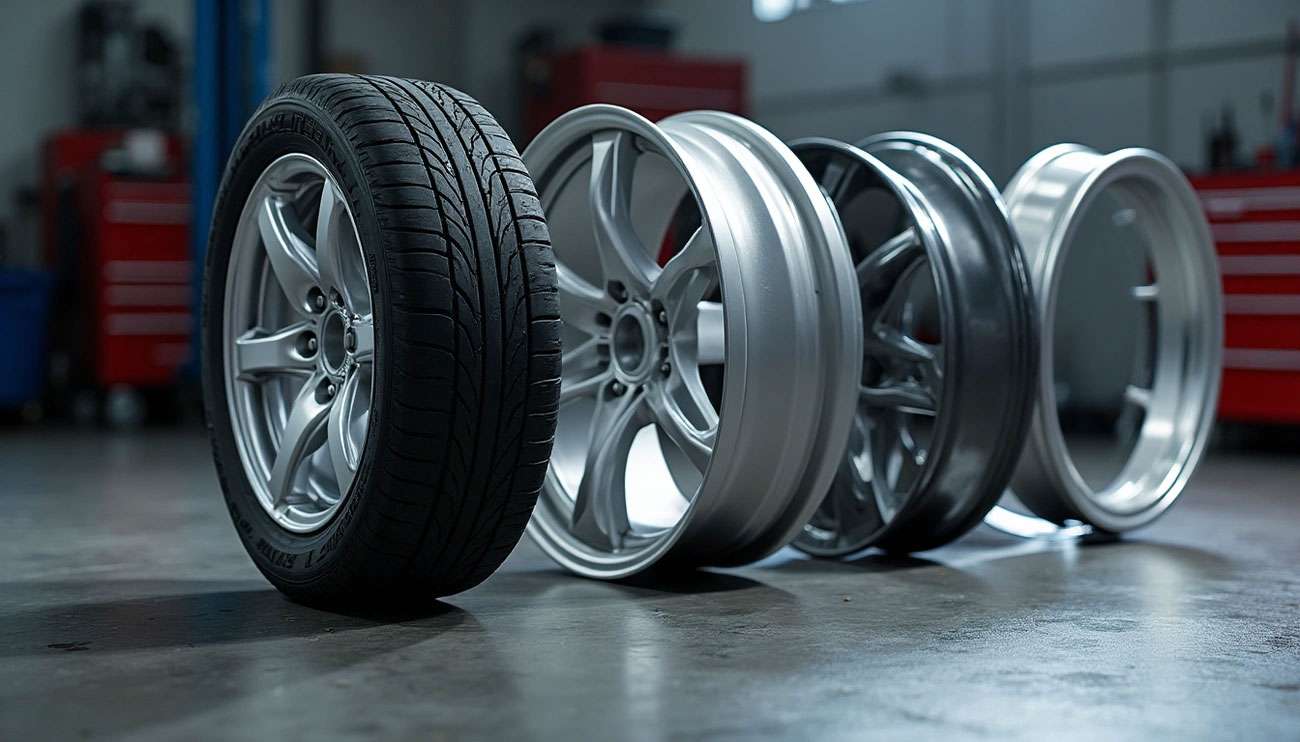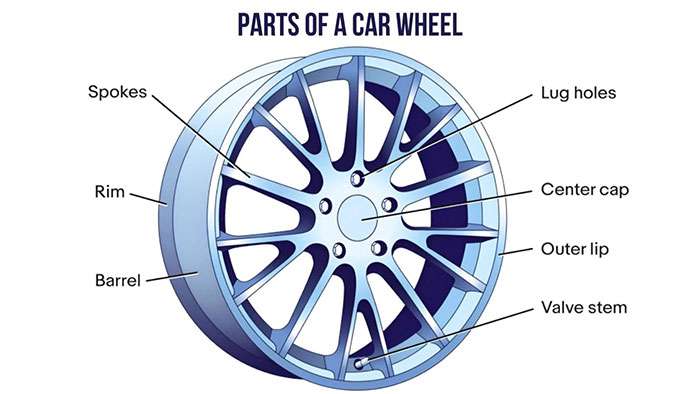
Understanding the tire vs wheel vs rim difference is crucial for proper vehicle maintenance and customization. Many people use these terms interchangeably when discussing vehicle components, but each serves a distinct function in your vehicle's operation.
The wheel represents the entire metal circular structure that attaches to your vehicle's hub and rotates to keep your vehicle moving. The rim, however, refers specifically to the outermost part of the wheel that holds the tire in place. The tire is the rubber casing that wraps around the wheel rim and maintains contact with the road surface.
When it comes to vehicle upgrades or maintenance issues, knowing the difference between wheels and rims becomes essential. The wheel includes multiple components such as the hub and central disk that connects to your vehicle's axle. Fitting the right wheels and tires to your vehicle affects more than just aesthetics—it directly impacts performance, safety, and stability[-4].
We'll clarify these commonly confused components and explain their distinct functions in your vehicle's anatomy. This knowledge helps you make informed decisions about maintenance and modifications while communicating effectively with automotive professionals.
Understanding your vehicle's wheel system requires recognizing three distinct components. Each part serves a specific function, and knowing these differences becomes essential for proper maintenance and upgrades.
Tires represent the only part of your vehicle that makes direct contact with the road surface. Modern tires are pneumatically inflated structures composed of synthetic rubber, natural rubber, fabric, wire, and carbon black, designed to provide traction while absorbing shock. They create a footprint (contact patch) that matches the vehicle's weight distribution without deforming the road surface.
Each tire consists of two main sections: the tread and body. The tread delivers necessary traction, while the body contains compressed air. The sidewall bridges between the tread and bead, offering tensile strength and flexibility. Tires directly affect your vehicle's handling, ride quality, braking, and overall safety by cushioning the roughness of bumpy terrains.
The wheel comprises the entire metal structure that connects to your vehicle's hub through an axle. Made from pressed and welded steel or lightweight metal alloys such as aluminum or magnesium, wheels serve as the structural foundation connecting tires to your vehicle.
A complete wheel consists of several components working together. The hub forms the central portion connecting to the vehicle's axle. Spokes radiate outward from the hub, connecting it to the circular outer edge. The barrel forms the inner portion that helps maintain the tire's shape and supports air retention. The wheel transfers the engine's power to the ground through the drivetrain, enabling forward motion.
The rim specifically refers to the outermost circular part of the wheel. This U-shaped outer edge holds and secures the tire in place. The rim's primary function involves supporting and sealing the tire to the wheel while maintaining air inside tubeless tires by ensuring an appropriate fit.
The rim includes several crucial components: the rim flange contacts the tire bead, helping secure it in position. The barrel houses the drop center, which is essential for mounting and dismounting tires. This design determines what tire size fits your vehicle, making proper wheel and tire compatibility essential.

Image Source: The Engineering Choice
While these components work together as a system, tires, wheels, and rims serve distinct functions that directly impact vehicle handling, performance, and safety. Understanding these differences helps you make informed decisions about maintenance and upgrades.
The wheel encompasses the entire metal structure, including the hub, spokes, center disk, and rim. The rim represents only the outer circumference where tire mounting occurs. Consider the rim as just one component within the complete wheel assembly.
Your vehicle connects to the wheel through the hub, which attaches to the axle via lug nuts. The rim serves as the reinforcement edge that secures the tire and creates an airtight seal for maintaining proper tire pressure. This U-shaped outer section features a deeper center that slopes toward shallower edges, specifically designed to support the tire bead.
Wheels provide the structural foundation made from steel, aluminum alloys, or carbon fiber materials. Tires consist of rubber compounds reinforced with steel or fabric materials.
The wheel supports your vehicle's weight and enables rotation by connecting directly to the axle. Tires provide traction, absorb road shocks, and maintain stability across different surfaces. The key distinction: wheels never touch the road surface, while tires form the critical interface between your vehicle and pavement.
The rim-tire relationship represents a critical mechanical interface. The rim supports and seals the tire to the wheel, maintaining air inside tubeless tires through proper fit. Tires create friction with the road through their treads and grooves.
The rim flange contacts the tire bead to secure it in position, but the rim itself never touches the road. The precise relationship between rim width and tire dimensions affects handling characteristics significantly. Some tire widths can vary by up to 3.6mm (15%) depending on the rim they're mounted on.
Understanding these relationships helps you select compatible components that work together for optimal performance and safety.
The terminology mix-up between wheels and rims continues throughout automotive discussions, even among experienced car enthusiasts. This confusion stems from several cultural and linguistic factors that have developed over time.
Automotive aftermarket culture has been the primary driver behind wheel-rim terminology confusion. When custom wheels gained popularity, the term "rims" gradually moved from niche communities into mainstream vocabulary. This happened because enthusiasts focused on the most eye-catching component—the rim portion—and eventually started calling the entire wheel assembly by this single feature. Certain styles like deep dish wheels with dramatic rim designs made the distinction between technical terms and slang usage even more blurred.
Marketing campaigns have played a major role in terminology confusion. The phrase "nice rims" became the go-to compliment for attractive wheels, and it simply sounds better than "nice wheels" in automotive talk. This preference for "rim" over "wheel" in marketing materials has become deeply embedded in everyday language. The term has become so widespread that tire stores, car shows, and sales advertisements regularly use "rims" when they mean "custom wheels" or "alloy wheels".
Where you live significantly affects how people describe vehicle components. What one region calls a "wheel" might be commonly referred to as a "rim" somewhere else. International terminology varies even more dramatically—Germany makes clear distinctions between "Reifen" (tire), "Felge" (rim), and "Rad" (wheel), while Spanish-speaking regions use terms like "rueda," "llanta," and "rin" differently depending on which country you're in.
Maintaining your vehicle's wheels, tires, and rims in optimal condition ensures safety and performance on the road. Recognizing warning signs early prevents costly repairs and dangerous driving situations.
Damaged rims make themselves known through persistent vibrations in your steering wheel, seat, or floorboard. These vibrations typically worsen at higher speeds, signaling potential balance problems. Slow air leaks present another clear warning—if one tire consistently loses pressure while others stay inflated, a bent or cracked rim might be breaking the seal between tire and wheel. Unusual sounds like clunking, thumping, or clicking also demand immediate attention.
Modern tires come with built-in treadwear indicators (wear bars)—raised sections that show when tread depth hits 2/32 inch, the legal minimum. At this point, replacement becomes necessary for both safety and legal reasons. The penny test gives you a quick check at home: place a penny with Lincoln's head upside down into the tread; if you can see his entire head, your tires need replacing. For better wet-weather performance, consider new tires once tread reaches 4/32 inch.
Potholes pose a serious threat to wheel integrity, potentially causing bent or cracked rims, air leaks, and alignment problems. After hitting a significant pothole, check your wheels for visible damage and watch for steering problems or pulling to one side. Curb impacts during parking can similarly harm wheel components, creating scuffs, dents, or structural damage.
Professional evaluation becomes important after impact incidents or when you experience unexplained handling issues. Experts can spot internal damage that's invisible during casual inspection. After five years, professional inspection becomes crucial regardless of how the tires look, with many manufacturers recommending tire replacement after 6-10 years no matter what the tread depth shows. Regular professional checks help catch potential problems before they affect safety or lead to expensive repairs.
Understanding the distinct roles of tires, wheels, and rims proves essential for vehicle owners who want to make informed maintenance and upgrade decisions. We've clarified these commonly confused components and their unique functions in your vehicle's operation.
The confusion between these terms stems from aftermarket culture, marketing influences, and regional language differences. While this mix-up is common, it can lead to miscommunication when discussing vehicle maintenance or shopping for upgrades.
Recognizing replacement indicators becomes crucial for safety and performance. Vibrations and air leaks signal rim damage, while tread wear indicators show when tires need replacement. Pothole or curb impacts can compromise wheel integrity and require professional assessment.
This knowledge empowers you to communicate effectively with mechanics and tire professionals. Whether you're discussing repairs or shopping for custom wheels, knowing exactly what you need ensures you get the right components for your vehicle.
The next time someone compliments your "rims," you'll know they're referring to just one part of your complete wheel assembly. More importantly, you'll be equipped to maintain your vehicle's performance and safety standards with confidence.
At Performance Plus Tire, we believe informed customers make better decisions. That's why we provide expert guidance to help you select the perfect wheels and tires for your specific needs. Ready to upgrade your ride with the right components?
Understanding the difference between tires, wheels, and rims is essential for proper vehicle maintenance, safety, and effective communication with automotive professionals.
• Tires are rubber casings that contact the road and provide traction, while wheels are the complete metal structure connecting to your vehicle's axle.
• Rims are only the outer edge of the wheel that secures the tire—not the entire wheel assembly despite common usage.
• Replace tires when tread reaches 2/32 inch using the penny test, and inspect wheels after pothole impacts for damage signs like vibrations.
• Professional inspection becomes essential after five years regardless of visible condition, with many manufacturers recommending replacement after 6-10 years.
• Marketing and aftermarket culture have blurred these distinctions, making "rims" popular slang for custom wheels despite technical inaccuracy.
This knowledge empowers you to make informed maintenance decisions and communicate accurately when discussing vehicle repairs or upgrades with mechanics and tire professionals.
A wheel is the entire metal structure that attaches to your vehicle's hub, while the rim is specifically the outer edge of the wheel that secures the tire in place. The wheel includes components like the hub, spokes, and rim.
The term "rims" has become popular slang for custom wheels, largely due to aftermarket culture and marketing influences. This usage, while common, is technically inaccurate as rims are just one component of the entire wheel assembly.
Professional tire inspection becomes essential after five years, regardless of visible condition. Many manufacturers recommend tire replacement after 6-10 years, even if tread depth appears adequate.
Key indicators include when tread depth reaches 2/32 inch (easily checked with the penny test), uneven wear patterns, visible damage, or if tires are over 6 years old. For optimal wet-weather performance, consider replacement when tread reaches 4/32 inch.
Pothole impacts can cause bent or cracked rims, air leaks, and alignment issues. After hitting a significant pothole, inspect your wheels for visible damage and monitor for steering problems or pulling to one side. Professional assessment may be necessary to detect internal damage.